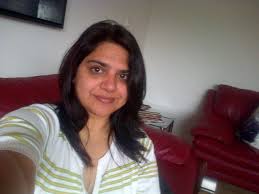Contribute
| In Conversation With Shalini Khanna, Director NAB Center For Blind Women |
Nirmala Garimella
07/03/2014
Shalini Khanna, is the Director of the NAB center of Blind Women and Disabilities in New Delhi India. She holds a Masters in English literature; a diploma in Rehab for visually impaired from Rehab Council of India, and is a Qualitative Market Researcher for Quantum, GFK Mode, Technopak, HTA. In the last nine years, the NAB India Centre has supported directly more than 550 total blind women beneficiaries, to access higher education, gain employment and become self-reliant, and rehabilitated them to not only find gainful careers but also set up their homes with successful marriages. The blind women come to the centre from different States of the country like Bihar, Uttrakhand, M.P., U.P., Rajasthan, Haryana, H.P., Punjab, Jammu, Manipur, Assam and even from the neighboring countries like Nepal. In less than a decade the centre has many achievements to its credit and is today proud to bridge the gap between education and empowerment, trainings and employments, between schooling and actual rehabilitation for the visually impaired girls. Shalini Khanna was in Boston recently as an active partner for the American India Foundation’s work among the Disabled. What lead you to this work with NAB? The Integrated way of education that NAB has pioneered in India which mainstreams the blind students along with the sighted is what attracted me. With an objective to bring a change in their way of life and bring reforms in the residential services, I joined NAB school in 1998. Can you share some statistics about the status of blind women in India? 50% of the staggering 15 million blind populations are women. Only 30% of the blind women are able to receive education due to lack of residential facilities. And only a negligible 1% of the blind women are able to receive employment due to obsolete trainings and lack of gender sensitive support system. In India approx. 10 million in India are blind, 5% educated, and only 2-3% in gainful employment. It is a vital need. On your recent trip to USA, How do you find the response of the diaspora to development issues in India? I visited Dallas and the Radio Resource center for the Blind where we were exposed to a new service, especially the Call and Listen service for the blind which could be very effective even in India as we have a lot of volunteer to help us record books in India. Also the meeting with Lighthouse Director Korrie and Karen and Wanda from Bharuch College and Pennsylvania Institute respectively was a good introduction to availability of varied Technology for the Blind in America. We were also glad to observe the sincere involvement of the Indian Diaspora in the development of the underdeveloped sections of India. How can our readers help and reach out? Blind girls in India require a lot of support for education and employment with help of technology and assistance. Readers in America could sensitize their Indian friends in India to employ more visually impaired bright youth and start diversity in their work places. If they can support the education of the visually impaired girl child in India financially and with technical devices it would help these girls go a long way.
You may also access this article through our web-site http://www.lokvani.com/
